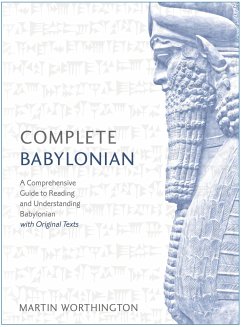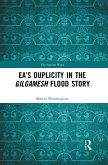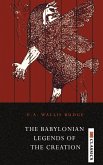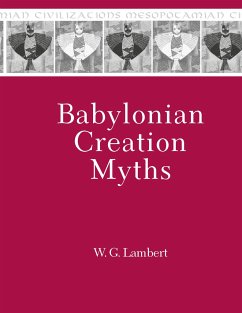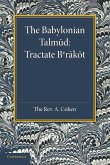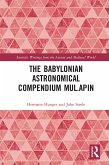Martin Worthington
Complete Babylonian
A Comprehensive Guide to Reading and Understanding Babylonian, with Original Texts
Martin Worthington
Complete Babylonian
A Comprehensive Guide to Reading and Understanding Babylonian, with Original Texts
- Broschiertes Buch
- Merkliste
- Auf die Merkliste
- Bewerten Bewerten
- Teilen
- Produkt teilen
- Produkterinnerung
- Produkterinnerung
A complete course on reading and understanding Babylonian, designed for absolute beginners, built around authentic texts and inscriptions.
Andere Kunden interessierten sich auch für
![Ea's Duplicity in the Gilgamesh Flood Story Ea's Duplicity in the Gilgamesh Flood Story]() Martin WorthingtonEa's Duplicity in the Gilgamesh Flood Story37,99 €
Martin WorthingtonEa's Duplicity in the Gilgamesh Flood Story37,99 €![Of Fire and Lions Of Fire and Lions]() Mesu AndrewsOf Fire and Lions14,99 €
Mesu AndrewsOf Fire and Lions14,99 €![Late Babylonian Administrative and Legal Texts, Concerning Craftsmen, from the Eanna Archive Late Babylonian Administrative and Legal Texts, Concerning Craftsmen, from the Eanna Archive]() Yuval LevaviLate Babylonian Administrative and Legal Texts, Concerning Craftsmen, from the Eanna Archive135,99 €
Yuval LevaviLate Babylonian Administrative and Legal Texts, Concerning Craftsmen, from the Eanna Archive135,99 €![The Babylonian Legends of the Creation The Babylonian Legends of the Creation]() Sir E a Budge WallisThe Babylonian Legends of the Creation23,99 €
Sir E a Budge WallisThe Babylonian Legends of the Creation23,99 €![Babylonian Creation Myths Babylonian Creation Myths]() W.G. LambertBabylonian Creation Myths122,99 €
W.G. LambertBabylonian Creation Myths122,99 €![The Babylonian Talmud The Babylonian Talmud]() The Babylonian Talmud53,99 €
The Babylonian Talmud53,99 €![Babylonian Astronomical Compendium MUL.APIN Babylonian Astronomical Compendium MUL.APIN]() Hermann HungerBabylonian Astronomical Compendium MUL.APIN58,99 €
Hermann HungerBabylonian Astronomical Compendium MUL.APIN58,99 €-
-
-
A complete course on reading and understanding Babylonian, designed for absolute beginners, built around authentic texts and inscriptions.
Hinweis: Dieser Artikel kann nur an eine deutsche Lieferadresse ausgeliefert werden.
Hinweis: Dieser Artikel kann nur an eine deutsche Lieferadresse ausgeliefert werden.
Produktdetails
- Produktdetails
- Verlag: John Murray Press
- Seitenzahl: 448
- Erscheinungstermin: 4. Oktober 2018
- Englisch
- Abmessung: 249mm x 192mm x 27mm
- Gewicht: 1056g
- ISBN-13: 9781473627802
- ISBN-10: 147362780X
- Artikelnr.: 48812515
- Herstellerkennzeichnung
- Libri GmbH
- Europaallee 1
- 36244 Bad Hersfeld
- gpsr@libri.de
- Verlag: John Murray Press
- Seitenzahl: 448
- Erscheinungstermin: 4. Oktober 2018
- Englisch
- Abmessung: 249mm x 192mm x 27mm
- Gewicht: 1056g
- ISBN-13: 9781473627802
- ISBN-10: 147362780X
- Artikelnr.: 48812515
- Herstellerkennzeichnung
- Libri GmbH
- Europaallee 1
- 36244 Bad Hersfeld
- gpsr@libri.de
Martin Worthington
: INTRODUCTION
: The Language’s Relatives and Development
: What about Assyrian?
: A note on Sumerian
: Pronunciation
: About the exercises
: THE CUNEIFORM SCRIPT, TRANSLITERATION AND NORMALIZATION
: Phonetic writing
: Sumerographic writing and phonetic complements
: Determinatives
: The cuneiform script: how it evolved
: Transliteration
: Which sign is being used to write a syllable?
: Normalization
: SOME GENERAL FEATURES OF THE LANGUAGE
: Roots and patterns
: Position of the verb within the sentence
: Articles
: Pronouns as subjects of verbs
: Sound changes
: Syllables and division into syllables (‘syllabification’)
: Sound change 1: vowel elision
: Sound change 2: vowel contraction
: Sound change 3: assimilation of consonants
: OVERVIEW OF NOUNS AND ADJECTIVES
: Case
: Gender
: Number
: Words functioning as nouns
: NOUNS AND ADJECTIVES, SINGULAR
: The second millennium BC
: The first millennium BC
: NOUNS AND ADJECTIVES, PLURAL
: The second millennium BC
: Masculine nouns:
: Masculine adjectives:
: Feminine nouns and adjectives:
: The first millennium BC
: HOW TO SAY ‘OF’: THE ‘CONSTRUCT STATE’
: Origin of ‘construct’ forms
: Formation of the ‘construct state’ in the singular
: Formation of the ‘construct state’ in the plural
: Use of the singular and plural construct forms
: ADVERBS AND LOCATIVES
: OVERVIEW OF VERBS
: The four verb systems
: The sub-systems: tn and t
: ‘Weak’ verbs
: Verbs with ‘a’ and verbs with ‘e’
: Tenses
: Pronouns and gender
: Summary
: THE PRESENT
: Forming the present for non-weak verbs s
: Forming the present for weak verbs
: THE PRETERITE
: THE PERFECT
: THE STATIVE
: VERBAL FORMS FOR ALL PERSONS
: HOW TO EXPRESS WISHES AND COMMANDS
: SUBORDINATE CLAUSES
: VERBS AND THE DIRECTION OF MOTION
: PRONOUNS
: THE DUAL
: A FEW TRICKS OF THE TRADE
: Sandhi spellings
: Puns
: Unorthodox syllable divisions
: Special sign readings
: Alphabetic influence
: Rebus writings
: Scribal errors resulting from copying
: Scribal errors resulting from dictation
: The structure of poetic lines
: Structural parallelism
: FURTHER READING
: APPENDIX: GLOSSED CUNEIFORM READINGS
: GLOSSARY
: The Language’s Relatives and Development
: What about Assyrian?
: A note on Sumerian
: Pronunciation
: About the exercises
: THE CUNEIFORM SCRIPT, TRANSLITERATION AND NORMALIZATION
: Phonetic writing
: Sumerographic writing and phonetic complements
: Determinatives
: The cuneiform script: how it evolved
: Transliteration
: Which sign is being used to write a syllable?
: Normalization
: SOME GENERAL FEATURES OF THE LANGUAGE
: Roots and patterns
: Position of the verb within the sentence
: Articles
: Pronouns as subjects of verbs
: Sound changes
: Syllables and division into syllables (‘syllabification’)
: Sound change 1: vowel elision
: Sound change 2: vowel contraction
: Sound change 3: assimilation of consonants
: OVERVIEW OF NOUNS AND ADJECTIVES
: Case
: Gender
: Number
: Words functioning as nouns
: NOUNS AND ADJECTIVES, SINGULAR
: The second millennium BC
: The first millennium BC
: NOUNS AND ADJECTIVES, PLURAL
: The second millennium BC
: Masculine nouns:
: Masculine adjectives:
: Feminine nouns and adjectives:
: The first millennium BC
: HOW TO SAY ‘OF’: THE ‘CONSTRUCT STATE’
: Origin of ‘construct’ forms
: Formation of the ‘construct state’ in the singular
: Formation of the ‘construct state’ in the plural
: Use of the singular and plural construct forms
: ADVERBS AND LOCATIVES
: OVERVIEW OF VERBS
: The four verb systems
: The sub-systems: tn and t
: ‘Weak’ verbs
: Verbs with ‘a’ and verbs with ‘e’
: Tenses
: Pronouns and gender
: Summary
: THE PRESENT
: Forming the present for non-weak verbs s
: Forming the present for weak verbs
: THE PRETERITE
: THE PERFECT
: THE STATIVE
: VERBAL FORMS FOR ALL PERSONS
: HOW TO EXPRESS WISHES AND COMMANDS
: SUBORDINATE CLAUSES
: VERBS AND THE DIRECTION OF MOTION
: PRONOUNS
: THE DUAL
: A FEW TRICKS OF THE TRADE
: Sandhi spellings
: Puns
: Unorthodox syllable divisions
: Special sign readings
: Alphabetic influence
: Rebus writings
: Scribal errors resulting from copying
: Scribal errors resulting from dictation
: The structure of poetic lines
: Structural parallelism
: FURTHER READING
: APPENDIX: GLOSSED CUNEIFORM READINGS
: GLOSSARY
: INTRODUCTION
: The Language’s Relatives and Development
: What about Assyrian?
: A note on Sumerian
: Pronunciation
: About the exercises
: THE CUNEIFORM SCRIPT, TRANSLITERATION AND NORMALIZATION
: Phonetic writing
: Sumerographic writing and phonetic complements
: Determinatives
: The cuneiform script: how it evolved
: Transliteration
: Which sign is being used to write a syllable?
: Normalization
: SOME GENERAL FEATURES OF THE LANGUAGE
: Roots and patterns
: Position of the verb within the sentence
: Articles
: Pronouns as subjects of verbs
: Sound changes
: Syllables and division into syllables (‘syllabification’)
: Sound change 1: vowel elision
: Sound change 2: vowel contraction
: Sound change 3: assimilation of consonants
: OVERVIEW OF NOUNS AND ADJECTIVES
: Case
: Gender
: Number
: Words functioning as nouns
: NOUNS AND ADJECTIVES, SINGULAR
: The second millennium BC
: The first millennium BC
: NOUNS AND ADJECTIVES, PLURAL
: The second millennium BC
: Masculine nouns:
: Masculine adjectives:
: Feminine nouns and adjectives:
: The first millennium BC
: HOW TO SAY ‘OF’: THE ‘CONSTRUCT STATE’
: Origin of ‘construct’ forms
: Formation of the ‘construct state’ in the singular
: Formation of the ‘construct state’ in the plural
: Use of the singular and plural construct forms
: ADVERBS AND LOCATIVES
: OVERVIEW OF VERBS
: The four verb systems
: The sub-systems: tn and t
: ‘Weak’ verbs
: Verbs with ‘a’ and verbs with ‘e’
: Tenses
: Pronouns and gender
: Summary
: THE PRESENT
: Forming the present for non-weak verbs s
: Forming the present for weak verbs
: THE PRETERITE
: THE PERFECT
: THE STATIVE
: VERBAL FORMS FOR ALL PERSONS
: HOW TO EXPRESS WISHES AND COMMANDS
: SUBORDINATE CLAUSES
: VERBS AND THE DIRECTION OF MOTION
: PRONOUNS
: THE DUAL
: A FEW TRICKS OF THE TRADE
: Sandhi spellings
: Puns
: Unorthodox syllable divisions
: Special sign readings
: Alphabetic influence
: Rebus writings
: Scribal errors resulting from copying
: Scribal errors resulting from dictation
: The structure of poetic lines
: Structural parallelism
: FURTHER READING
: APPENDIX: GLOSSED CUNEIFORM READINGS
: GLOSSARY
: The Language’s Relatives and Development
: What about Assyrian?
: A note on Sumerian
: Pronunciation
: About the exercises
: THE CUNEIFORM SCRIPT, TRANSLITERATION AND NORMALIZATION
: Phonetic writing
: Sumerographic writing and phonetic complements
: Determinatives
: The cuneiform script: how it evolved
: Transliteration
: Which sign is being used to write a syllable?
: Normalization
: SOME GENERAL FEATURES OF THE LANGUAGE
: Roots and patterns
: Position of the verb within the sentence
: Articles
: Pronouns as subjects of verbs
: Sound changes
: Syllables and division into syllables (‘syllabification’)
: Sound change 1: vowel elision
: Sound change 2: vowel contraction
: Sound change 3: assimilation of consonants
: OVERVIEW OF NOUNS AND ADJECTIVES
: Case
: Gender
: Number
: Words functioning as nouns
: NOUNS AND ADJECTIVES, SINGULAR
: The second millennium BC
: The first millennium BC
: NOUNS AND ADJECTIVES, PLURAL
: The second millennium BC
: Masculine nouns:
: Masculine adjectives:
: Feminine nouns and adjectives:
: The first millennium BC
: HOW TO SAY ‘OF’: THE ‘CONSTRUCT STATE’
: Origin of ‘construct’ forms
: Formation of the ‘construct state’ in the singular
: Formation of the ‘construct state’ in the plural
: Use of the singular and plural construct forms
: ADVERBS AND LOCATIVES
: OVERVIEW OF VERBS
: The four verb systems
: The sub-systems: tn and t
: ‘Weak’ verbs
: Verbs with ‘a’ and verbs with ‘e’
: Tenses
: Pronouns and gender
: Summary
: THE PRESENT
: Forming the present for non-weak verbs s
: Forming the present for weak verbs
: THE PRETERITE
: THE PERFECT
: THE STATIVE
: VERBAL FORMS FOR ALL PERSONS
: HOW TO EXPRESS WISHES AND COMMANDS
: SUBORDINATE CLAUSES
: VERBS AND THE DIRECTION OF MOTION
: PRONOUNS
: THE DUAL
: A FEW TRICKS OF THE TRADE
: Sandhi spellings
: Puns
: Unorthodox syllable divisions
: Special sign readings
: Alphabetic influence
: Rebus writings
: Scribal errors resulting from copying
: Scribal errors resulting from dictation
: The structure of poetic lines
: Structural parallelism
: FURTHER READING
: APPENDIX: GLOSSED CUNEIFORM READINGS
: GLOSSARY

